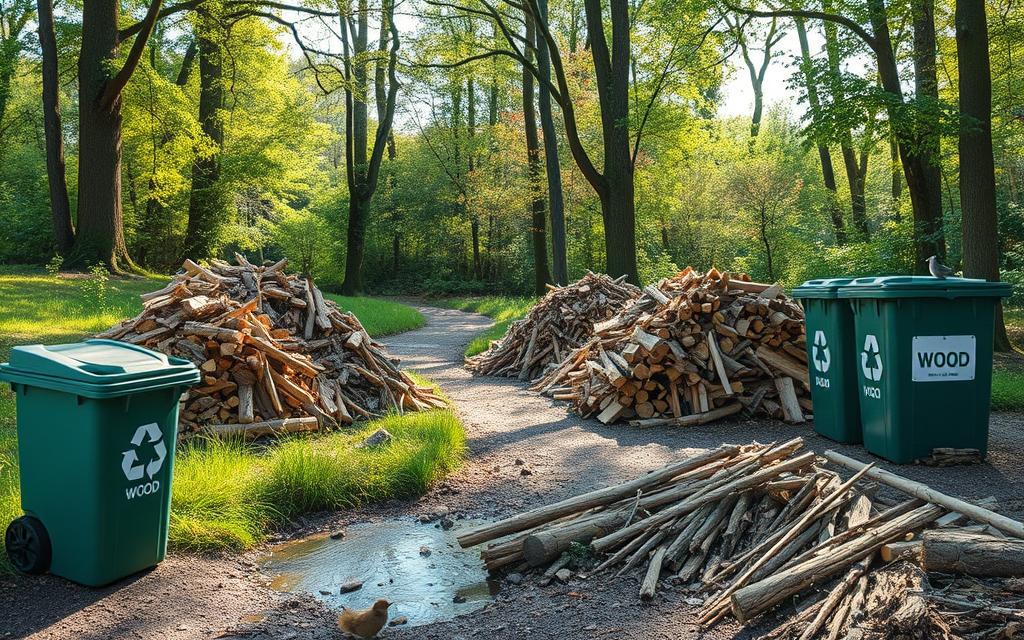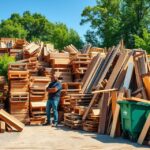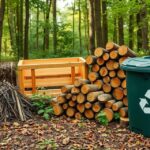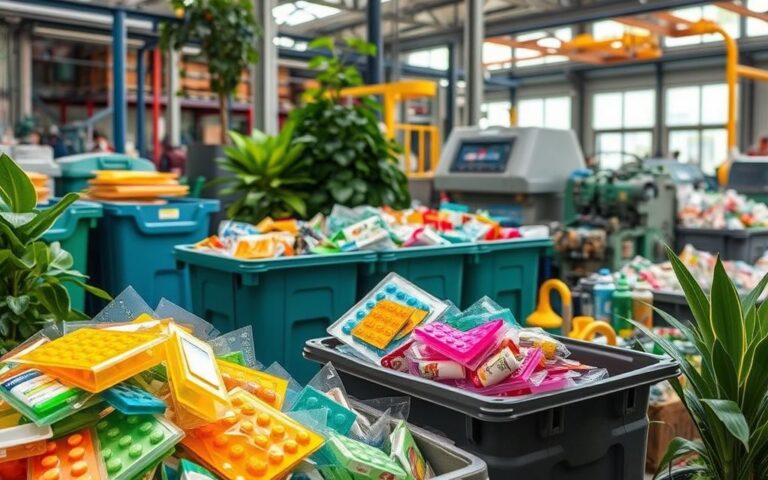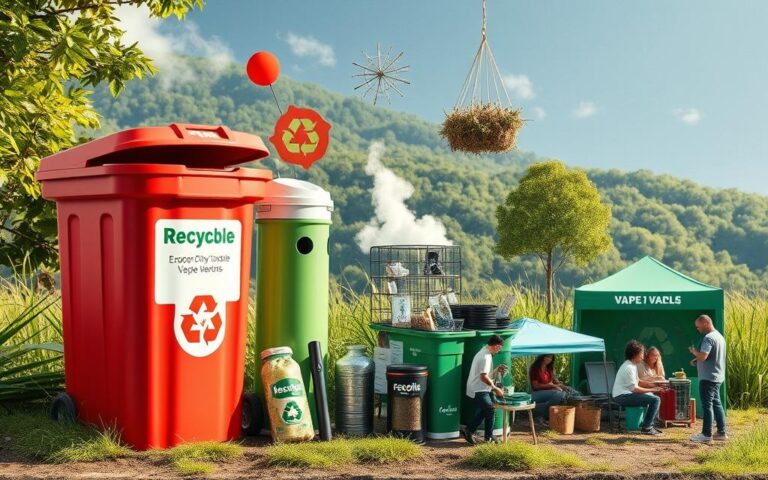Can You Put Wood in the Recycle Bin? Eco-Friendly Disposal
Many people wonder if they can recycle wood in the usual way. Wood is indeed recyclable, but it often can’t go in your recycle bin. This is because it might contaminate other recyclables, causing more problems.
To manage wood waste well, knowing how to dispose of it is key. This article will cover how to recycle wood properly. We’ll look at doing creative DIY projects or using wood recycling facilities. By doing this, we can all help make waste disposal better and more eco-friendly.
Understanding the Recycling Process
The recycling process takes a few critical steps. These steps help recover and reuse materials effectively. A clean recycling system is key for keeping materials in good shape. Recycling is vital as it keeps a lot of waste, like wood, out of landfills. In 2019, a big amount of wood was thrown away, showing we need better ways to handle wood waste.
The Importance of Proper Recycling
Right recycling methods reduce the risk of contamination. This lets us recycle things like paper and plastic smoothly. Sometimes, non-recyclable items, especially wood, get mixed with recyclables. This can slow down the recycling process. The Wood Waste Regulations 2023 sort wood waste into different types, like clean timber. This helps us get rid of it the right way. Keeping the recycling stream clean makes the whole process work better.
The Role of Material Recovery Facilities (MRFs)
Material Recovery Facilities (MRFs) are crucial for sorting recyclables. They mainly sort items like glass and plastic. But, many MRFs struggle to handle wood properly. If wood isn’t dealt with right, it can contaminate recyclables. This might mean good materials get thrown away.
It’s important to manage wood waste well to improve recycling. Recycled wood is used for many things. About 65% becomes biomass fuel, 26% is made into panel boards, and 9% is used for animal bedding and landscaping. For more info on wood recycling, check out this ultimate guide.
Can You Put Wood in the Recycle Bin?
It’s important to know how to dispose of wood correctly for recycling. Many are unsure if wood goes in curbside bins. This mainly depends on the rules in your area, which tell you what you can recycle.
Recycling Regulations Overview
Wood is often not accepted in curbside recycling due to processing issues. Typically, these programs focus on paper, plastic, and metal. Only a few can manage wood. It’s critical to check your area’s rules on recycling wood. For eco-friendly disposal, there are special wood recycling centres. They take clean wood and recycle it.
Contamination Issues Caused by Wood
Wood in recycling bins can cause contamination. “Dirty” woods, like treated or painted wood, can spoil recyclable materials. Such woods can even cause recyclers to reject whole loads. Clean wood, such as pallets and construction wood, is usually fine. However, dirty woods should go to waste disposal sites. Good disposal practices help make recycling better and our planet healthier.
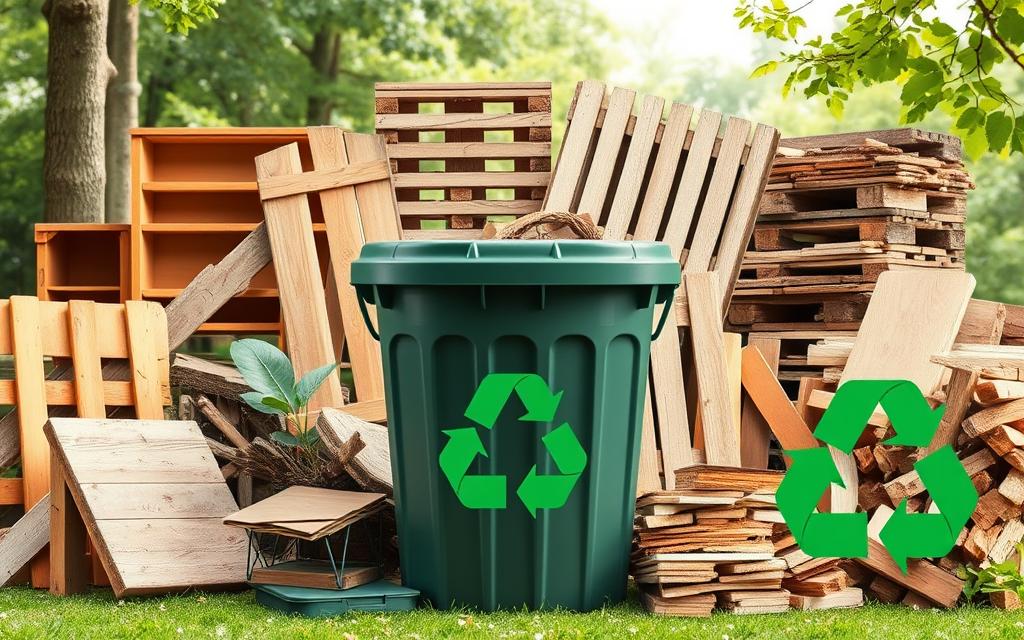
| Type of Wood | Acceptable for Recycling? | Disposal Method |
|---|---|---|
| Clean Wood (Shipping Pallets, Branches) | Yes | Recycling Facilities |
| Dirty Wood (Pressure Treated, Painted) | No | Municipal Waste Disposal |
| Woodworking Scraps | Yes | Recycling Facilities |
| Rotted Wood | No | Municipal Waste Disposal |
Alternative Disposal Methods for Wood
There are many innovative ways to dispose of wood responsibly. These methods cut down waste and boost community sustainability. We’ll look into how DIY projects and recycling facilities can make a difference in our approach to wood disposal.
Reusing Wood through Creative DIY Projects
Turning unwanted wood into useful or decorative items is an excellent reuse method. You can make furniture, garden planters, or wall art through DIY wood projects. This creativity allows people to work with their resources and avoid sending wood to landfills.
You can find plenty of project ideas online. This gives DIY enthusiasts exciting opportunities to use leftover wood. Clean wood can be disposed of in ways such as:
- Selling it on Craigslist or Facebook Marketplace
- Donating it to charities like Habitat for Humanity
- Using scraps for compost or firewood
Wood Recycling Facilities and Their Benefits
Wood recycling centres are key to proper wood disposal. They take in different wood types, especially untreated and clean scraps. Using these centres brings many benefits, such as:
- Turning reclaimed wood into new products like mulch, paper, or fuel
- Reducing the need for fresh lumber by offering a recycling loop
- Boosting local economies by providing recycled materials to businesses
It’s important to know about wood recycling facilities near you. Tools like Google Maps or Earth 911 help find these centres. Choosing to recycle wood helps the planet and supports sustainable waste handling.
Types of Wood Suitable for Recycling
Recycling wood helps the environment and cuts down landfill waste. It’s important to know which woods can be recycled for effective clean wood recycling. Not every type of wood is recyclable, especially when separating clean from dirty wood.
Clean versus Dirty Wood
Clean wood means untreated wood without any contaminants. You can find it in:
- Untreated pallets
- Wood cut-offs from workshops
- Yard waste
- Used lumber that has no stains or finishes
Dirty wood includes any painted, treated, or stained lumber. Such wood can’t be recycled as it might contaminate the process. Mixing clean wood with dirty wood should be avoided. It complicates the recycling and might increase disposal costs.
Common Types of Recyclable Wood Products
Recyclable wood has many uses once processed. Products from recycling clean wood include:
- Wood chips for landscaping and to control erosion
- Mulch for gardens and parks
- Sawdust for compost or animal bedding
- Particleboard or plywood for building
Some recycling centres might take in a bit of dirty wood but usually at an extra cost. It’s best to send only clean wood for recycling to get the most benefits. Proper disposal helps wood last longer and saves resources.
Unacceptable Wood Types for Recycling
Understanding which woods can’t be recycled is key to proper waste management. Some woods may seem okay but actually cause problems. Knowing these types helps prevent contamination and keep recycling programs running smoothly.
Pressure Treated and Painted Woods
Pressure-treated wood resists bugs and rot due to chemicals. But, these chemicals can leak out and make the wood bad for recycling. Woods that are painted, stained, or varnished are also no good for recycling. This is because the finishes pollute the recycling process. Both kinds need special disposal to avoid harm.
Dealing with Damaged or Infected Wood
Rot or bug damage makes wood unsuitable for recycling. This damaged wood can release dangerous toxins. It’s best to see it as waste, not something to recycle. Taking such wood to sites set up for hazardous waste helps. This way, you aid in keeping the recycling system clean and support a greener planet.
FAQ
Can I put any type of wood in the curbside recycling bin?
No, most wood types can’t go into curbside recycling because of contamination risks. Always check your local recycling rules.
What happens if wood ends up in the recycling bin?
Wood in the recycling bin can ruin other materials. This might lead to whole loads being thrown away, which increases landfill waste.
How can I recycle wood responsibly?
You can recycle wood by making DIY projects or going to a special wood recycling centre. These places take clean wood.
What is considered ‘clean’ wood?
‘Clean’ wood is untreated, like pallets or offcuts from woodwork. It’s recyclable without causing any contamination.
What types of wood should never be recycled?
Avoid recycling pressure-treated, painted or stained wood, and any wood that’s rotten or has bugs.
Are there benefits to using wood recycling facilities?
Yes, wood recycling centres are key for the environment. They turn clean wood into mulch, compost, or even new wood items.
What should I do with mouldy or insect-infested wood?
Take wood that’s mouldy or bug-infested to your local waste site designed for hazardous waste. It’s the safest option, following regulations.

